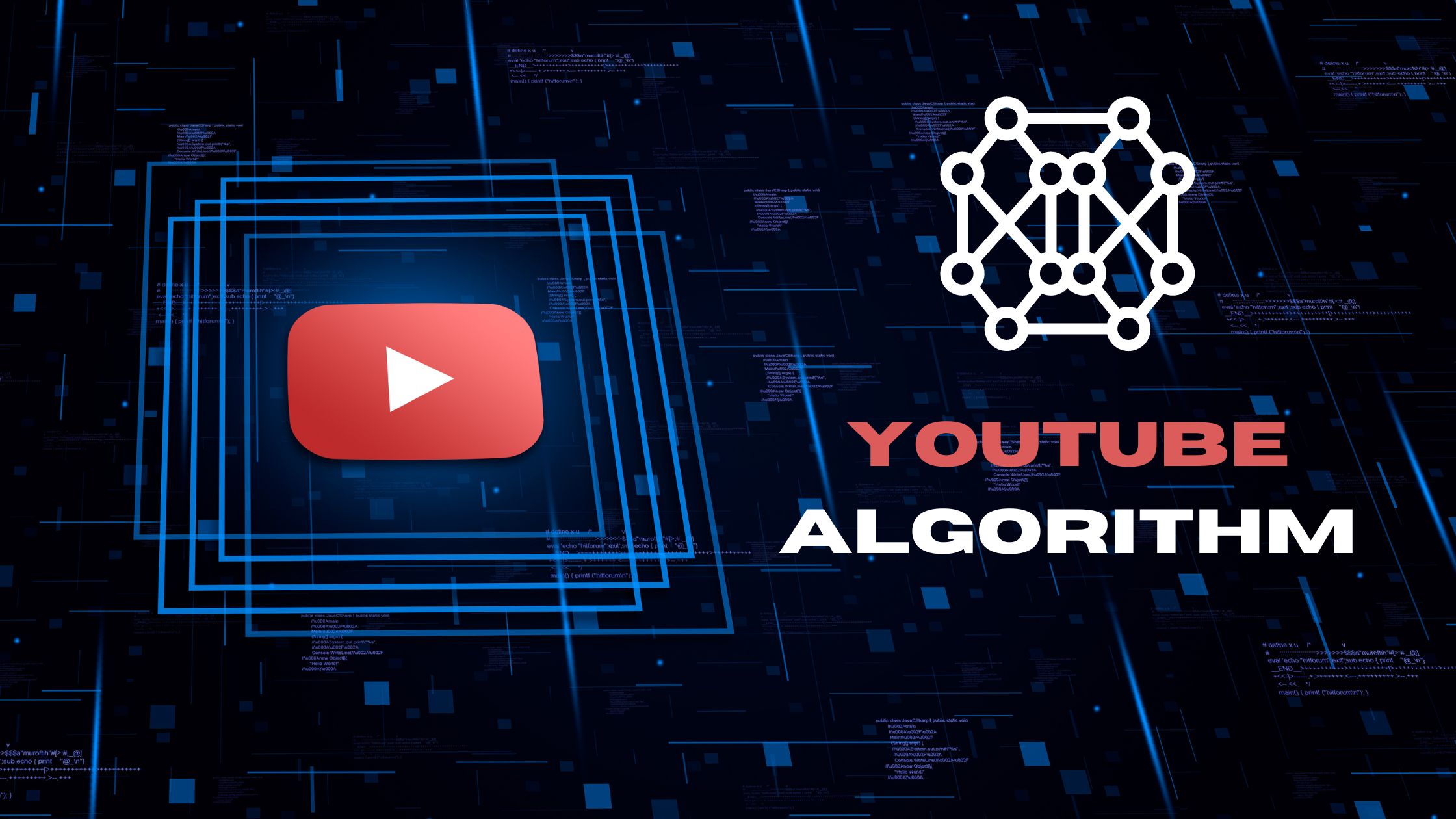
How Does YouTube Algorithm Work in 2025
Be it creators, influencers, brands, marketers, or other YouTubers, everyone has this one common question. The question is how does YouTube algorithm work and how to get the algorithm to suggest your videos. If you are here for finding the answer to this very question, then you’re at the right place. We’re sure by the end of this post, you’ll have the answer to this question related to the YouTube algorithm.
In this blog post, we’ll dive deep into what is the YouTube algorithm, and how it changed over the years, discuss how it works, and show you exactly the ways to get videos to perform to their full potential. So, without any further ado, let’s start with this ultimate blog post on YouTube algorithm. Let’s Start!
What is The YouTube Algorithm?

As you may or may not know, over 1 billion hours of videos are watched on YouTube by users worldwide. YouTube needs to ensure that every user gets the best experience while watching the videos. YouTube has a tough part of eliminating and suggesting videos to these 2 billion-plus human users (and untold numbers of feline users) to ensure the best experience.
To tackle all this in the best way and ensure users’ best experience on the platform, YouTube has its own algorithm. YouTube’s algorithm is nothing but a recommendation system that decides which videos to suggest and which not to users.
Now, let’s move on to the part where we’ll do a quick overview of how YouTube’s Algorithm has changed over the years and what it’s today.
YouTube Algorithm: 2005-2011
You must have heard of or come across the name Jawed Karim (a.k.a. the star of Me at the zoo). Well, according to him, YouTube, one of the biggest social media and video streaming platforms was created in 2005. YouTube was created to crowdsource videos of Janet Jackson and Justin Timberlake’s notorious Superbowl performances.
From that time till 2011, the YouTube algorithm used to recommend videos that attracted the most views or clicks. Alas, this working algorithm led to a proliferation of misleading titles and thumbnails by Youtubers. To make it more simple, this way of suggesting videos to users by the algorithm resulted in clickbait. Those algorithm-suggested videos left people feeling nothing but tricked, unsatisfied, or plain old annoyed. It was then that a change was made to the YouTube algorithm to enhance users’ experience.
YouTube Algorithm: 2012
It was in the year 2012, YouTube adjusted its algorithm and made a bit changes to its way of working. YouTube algorithm’s basis of suggesting videos to users switched from a recommendation system to support time spent watching each video. Now, suggesting videos also was based on time spent on the platform overall. It was then based on the fact that the right videos are watched by users for longer periods and perhaps even to the end.
However, YouTubers also found a loophole in this one and adopted a few tactics that’ll directly or indirectly push the algorithm to suggest their videos. First, there were these YouTubers who made their videos shorter so that viewers would watch to completion easily. Second, there were these YouTubers who made their videos longer to increase watch time overall easily.
Later, YouTube saw the pattern, got aware of this, and didn’t endorse either of these tactics. YouTube maintained the party line: make quality videos that are worth watching and the algorithm will definitely reward you. Focusing on the fact that time spent doesn’t necessarily mean quality time spent, YouTube again adjusted its algorithm.
YouTube Algorithm: 2015-2016
It was in the year 2015, YouTube started measuring the satisfaction and overall experience of users directly through several ways. YouTube started measuring this through surveys and prioritizing direct response metrics such as shares, likes, comments, etc. In this, YouTube also measured through the brutal “Not Interested” and “Dislike” buttons.
Later in the year 2016, YouTube released a whitepaper in which the inner workings of its AI were described in brief. The whitepaper released by Youtube revealed that the algorithm had gotten way more personal and detailed. Following all this, in the year 2018, the Chief Product Officer or CPO said that approximately 70% of the time spent by users on the platform watching videos recommended by the algorithm.
How Does the YouTube Algorithm Work at Present?
At present, the YouTube algorithm focuses only on two things. First, it’s about finding the right video for the preferences of each user. Second, it’s about encouraging those viewers to keep watching videos. The YouTube algorithm works and finds the right videos to suggest to users mainly on three parameters.
The first is personalization or analyzing users’ past history and preferences when it comes to watching videos. The second is performance, which is the traction and success metrics of videos. The third and final one is external factors, which deal with the overall audience or market for particular videos.
When we say “The YouTube Algorithm”, we talk about three slightly different but related selection or discovery systems. Well, these include the one that suggests videos for the YouTube homepage, the one that sorts videos to watch next, and the one that ranks videos on search results. Below, we’re going to dive in deeper and understand these three selection or discovery systems of the Youtube algorithm.
How YouTube Decides its Homepage Algorithm
YouTube decides which videos to show on the homepage of users based on two types of ranking signals. Well, the first is by measuring the performance of videos such as click-through rate, watch time, likes, dislikes, surveys, etc.
If those well-performing videos further appeal to, engages, and satisfies users, they climb up the SERPs and get shown to more viewers on their homepages. The second one deals with personalization, in which the YouTube algorithm offers videos that it so far thinks are relevant to users. For this, the algorithm analyzes users’ interests, past behavior, and watch history.
How YouTube Decides its Suggested Video Algorithm
When deciding on videos for users to watch next, the YouTube algorithm employs slightly different considerations. In this case, in addition to the above-discussed performance and personalization, the algorithm suggests videos that are often watched together by users. The algorithm also suggests videos that users have watched in the past and for which topics are related.
How YouTube Decides its Search Algorithm
As we’ve already reached halfway through this post, you must already know that no human is sitting at YouTube headquarters. You must know that no human entity is out there watching, ranking, and suggesting your videos to users. By all this, we are just trying to make you realize the importance of the Youtube algorithm We’re trying to make you realize that how your videos will perform completely lie with the Youtube algorithm.
As you may or may not know, YouTube is a search engine as much as a video and social media platform. Hence, the algorithm looks at your metadata, considers the keywords used, and then works based on these. It’s based on all these, the YouTube search algorithm determines what a particular video is about, the category it’s related to, and who might want to watch it.
Once the Youtube search algorithm has decided what your video is, it will show it to users actually looking for it in search results.
Ways To Get Noticed by The YouTube Algorithm:
With all these said about the YouTube algorithm, we finally come to the part for which you’ve been waiting for so long. It’s the part where you get to know exactly how to get the algorithm to recommend your videos. Below, we have discussed the most effective YouTube marketing plan you can use to help your videos perform best and grow your YouTube channel to the fullest.
-
Leverage The Power of Keywords
You can take the assistance of tools like Google Adwords, SEMrush, etc., to get the right keywords for your videos. Finally, you can then optimize your videos by using these keywords in mainly four places. You can use these keywords in your video’s file name, title, description, and script.
It’s often seen that some YouTubers use these keywords in the tags of their videos. However, we would suggest you avoid using these keywords as much as possible in tags.
-
Make Eye-Catching Thumbnail
The next best way to do so is by using thumbnails on your videos that are attractive, high-quality, and eye-catching. You should always aim to make it impossible for viewers to resist clicking on your thumbnails. However, you should throughout keep in mind not to clickbait the viewers using misleading thumbnails.
Thumbnails are the first thing viewers notice and they decide whether to watch a particular video or not. So, you should nail the thumbnails of your videos and also compliment them through a few other things. Firstly, you should always try to create custom and high-quality thumbnails. Secondly, you can complement your thumbnails with the help of catchy titles and relevant first sentences of your video descriptions.
-
Keep Your Viewers Engaged Throughout
You should make every one of your videos keeping in mind that the ultimate aim is to keep viewers watching your content. Your videos should be able to help viewers stay glued and stay within your channel’s ecosystem. To ensure this, you can ensure a few things on your videos.
First and foremost, you should ensure that your videos contain quality content. Your videos should have exactly the content that your audience is looking for, it’s only then they’ll stick till the very end.
In addition to the above, you can do so by adding cards to your YouTube videos. Well, adding cards on YouTube videos is nothing but flagging relevant other videos in videos. Secondly, you can put “End Screens” in your videos or end videos with the right CTAs. Thirdly, you can sort all the videos posted on your channel into different playlists based on the topic covered, content, etc. Last but not least, you can go for adding “Subscription Watermarks” to your videos.
-
Gain Organic Reach From Other Sources
Most YouTubers are unaware of this, but reach or traction on videos that come from outside the platform is noticed by the Youtube algorithm. The algorithm keeps a special track of those videos that can bring audiences from other sources to YouTube. These other sources include YouTube ads, external sites, other social media platforms, etc.
It’s a misconception of users that YouTube may punish videos for having a lot of outside traffic and traction. In fact, it’s the complete opposite as the traffic and traction from other sources contribute a lot to the ranking of your videos on YouTube as well as Google SEO.
-
Connect, Engage, & Collaborate
For all those looking to keep growing on YouTube and wants to achieve some milestone in the long term, this point is very important. All the YouTubers out there need to develop, maintain, and nurture relationships with their audience. The best way to do so is by connecting and engaging with them through responding to comments, giving shoutouts, mentions, etc. Not just the audience, but YouTubers also need to connect, engage, and even collaborate occasionally with other YouTubers.
All these will you as a YouTuber in relationship-building with your viewers and building trust. All these will help you build a loyal audience base who’ll make sure no matter what makes your videos get noticed by the algorithm.
-
Keep Experimenting
At the same time, you never know when or what changes may take place to the YouTube algorithm in the future. Also, you never know what will happen in the social media industry in the coming days like trends, features, etc., So, the only way to keep going and growing is by adapting to changes by experimenting.
You shouldn’t be afraid of experimenting with your content as well as your strategies because you never know what may lead to your success on YouTube. You can keep a track of trends using Google Trends, run new keyword research, make changes to your posting times, try different hashtags, and experiment in many more ways.
-
Stay Consistent
Last but not least, the ultimate way to achieve success on YouTube is by maintaining discipline and consistency. As long as you’ve got quality videos and you’re implementing the right YouTube marketing strategies, you should never quit.
Conclusion:
With all these said, we come to the end of this blog post on the working of the YouTube algorithm. As you’ve read this post till the end, we are sure you now know exactly how does YouTube algorithm work. Above, we’ve covered everything you need to know about the YouTube algorithm. But, if you’re still stuck with some queries & confusion or want us to cover something related to the YouTube algorithm, you can let’s know about it. You can easily let’s know about your queries, confusions, suggestions, etc., related to the YouTube algorithm through the comments below.




© Upviews 2022 All Rights Reserved.

















Related Posts
Top 16 Fashion YouTubers Who Are Trendsetters
January 23, 2024 3 Min Read
If you’re looking for a YouTube niche to make your name in, don’t discount fashion. Fashion is one of the most popular and potentially lucrative content niches on YouTube. YouTubers who produce content about fashion trends, styling tips, shopping hauls, and other apparel-related topics not only have a vast global audience ...
Continue Reading42 Lifestyle YouTubers Who Are Famous on YouTube
3 Min Read
Since YouTube is the home for long-form video content on the internet, it has also become a hub for a particular type of video: a lifestyle vlog. As a niche, lifestyle covers a wide range of subtopics – but they all come back to one central theme, which is content ...
Continue Reading20 DIY & Crafts YouTube Channels for Creative Inspiration
December 15, 2023 3 Min Read
Did you know that one of the most subscribed YouTube channels in the history of the platform produces DIY and crafting content? Clearly, viewers can’t get enough of videos that show them how to do everything from building their own furniture to cutting fruit in fun shapes to making their own ...
Continue Reading30+ Minecraft YouTubers with Exceptional Gaming Skills
December 11, 2023 3 Min Read
Minecraft – an online game in which players can build whatever they can imagine using the resources around them – is literally one of the most popular video games of all time. We’re not kidding! In fact, it’s the second most played PC game based on the number of monthly active ...
Continue Reading